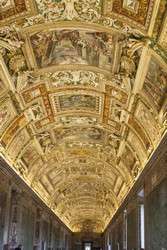LED lighting offers a cost-effective solution to protect artwork

Michelangelo's famous Sistine Chapel ceiling paintings in the Vatican have been brought to life with innovative light emitting diode (LED) lighting. The new installation, developed by the EU-funded LED4ART project, enables visitors to better appreciate the paintings and frescos, protects the artwork from damage and uses significantly less electricity than conventional lighting rigs.
This demonstration installation shows how museums and galleries can install flexible and effective lighting solutions that are also incredibly energy efficient. By replacing the Sistine Chapel's existing lighting system with the latest in LED technology, the project partners have been able to achieve electricity savings of up to 90 %.
LEDs based on inorganic semiconductors are incredibly efficient and offer a greener alternative to conventional lighting. They are mercury-free, have a long lifetime and could enable Europe to achieve significant energy savings if rolled out extensively.
By switching to LED lights, Europe could decrease carbon dioxide emissions from electric power use by up to 50 % in just over 20 years. Making the switch is therefore one of the most cost-effective and simple ways to tackle global warming using existing technology, resulting in a significant contribution to CO2 reduction at European level.
There was also of course an important conservation aspect to LED4ART. The project wanted to demonstrate how LED lighting can play an important role in the protection of artwork, as it is gentler than other forms of artificial light. At the same time, LED offers fantastic levels of illumination, ensuring that artwork can be fully appreciated by visitors.
This made the Vatican City's Sistine Chapel the ideal venue for LED4ART. World-famous for its 15th century frescos by the likes of Botticelli and Perugino and Michelangelo's ceiling masterpiece, the chapel receives millions of visitors every year. Ultraviolet light has been fading the colour of these 500-year old paintings for decades, so a practical solution was needed that would enable people to enjoy the paintings in a more protective environment.
The solution was to switch the chapel's lighting from conventional bulbs to LED. The LED4ART project installed around 7 000 LEDs in the chapel, concealed beneath a ledge that runs the length of the room. The colour spectrum of each light was custom-made to ensure that the light emitted was as close as possible to natural light; there are no disproportionate blues or reds that might affect viewing.
The LED installation ensures that the artwork is uniformly illuminated, and that the frescos can be appreciated in their entirety. The flexibility of the installation means that each light can be adjusted to give the impression that the chapel is continuously bathed in natural light.
More information: For further information, please visit: LED4ART www.led4art.eu/
Provided by CORDIS

















